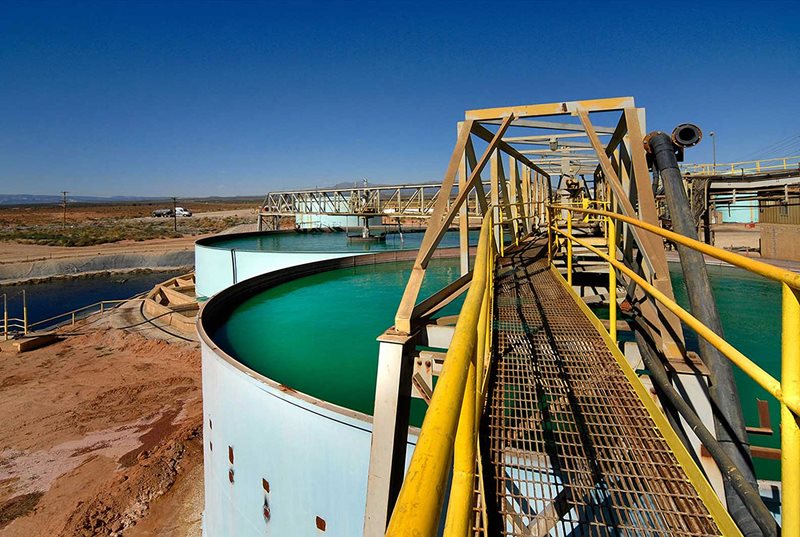Energy Fuels Inc. (NYSE: UUUU) (TSX: EFR) started uranium production at three uranium mines in Arizona and Utah, spurred on by strong uranium market conditions, including a 16-year high at nearly $90.00 per pound of uranium oxide (U3O8).
The company announced on Thursday it was preparing two additional mines in Colorado and Wyoming for production, which it anticipates starting within a year. Energy Fuels is also seeking permits on several other large-scale mining projects in the United States to help increase production rates in the years to come.
Energy Fuels has more licensed uranium production capacity than any other U.S. company, with a capacity exceeding 10 million pounds of U3O8 per year.
The company operates the sole conventional uranium mill in the United States, maintains an in situ recovery (ISR) facility, and possesses several permitted mines at various stages of production, development, and standby.
Additionally, Energy Fuels boasts one of the largest in-ground uranium (and vanadium) resource portfolios in the U.S. Over the past five years, the company has been responsible for two-thirds of all U.S. uranium production.
The company plans to increase production at three mines by mid to late-2024, aiming to achieve an annual uranium production rate ranging from 1.1 to 1.4 million pounds.
During 2024, however, Energy Fuels will mine ore from these three mines and store it at its White Mesa Mill in Utah for processing in 2025. This is contingent upon market conditions, contract requirements and the Mill schedule.
If market conditions remain favourable as anticipated, this move will raise Energy Fuels’ uranium production to over two million pounds of U3O8 per year, beginning in 2025.
Read more: ATHA Energy defines 18 high-priority prospective mining targets after EM survey
Read more: ATHA Energy aerial surveys over Athabasca Basin reveal strong potential for uranium
State-owned Russian uranium company warns of potential export ban
The company’s choice to increase uranium production comes from various advantageous market and policy factors. These include rising uranium prices and the increasing endorsement of nuclear energy as a means to combat climate change.
Also, as Russia’s territorial aggression remains unabated, the United States has realized a need to cut dependence on Russian-controlled uranium.
According to Energy Department data, Russia supplied nearly a quarter of the enriched uranium used in America’s over 90 commercial reactors last year, making it the top foreign supplier to the US.
Earlier this month, Russian state-owned uranium company Tenex warned its American customers that the Kremlin might begin proactively blocking exports of nuclear fuel to the U.S. if Washington bans imports starting in 2028.
Tenex’s US subsidiary has advised electric companies, including Constellation Energy Corp. (NASDAQ: CEG), Duke Energy Corp (NYSE: DUK), and Dominion Energy Inc. (NYSE: D), to get ready for such a possibility.
Russia’s state nuclear corporation Rosatom, the owner of Tenex, has predictably denied issuing any warnings to its US customers.
Blocking exports could potentially disrupt uranium markets, leading to price spikes for nuclear reactor fuel.
Smaller utilities may find it challenging to manage these increased prices.
Meanwhile, a House-passed measure seeking to ban enriched uranium Russian imports failed to pass the Senate on Thursday. However, the widely supported legislation could resurface.
The potential for a Russian ban notwithstanding, the real beneficiaries here are companies operating in other jurisdictions. Chief among these are those operating in Saskatchewan’s Athabasca Basin.
Read more: ATHA Energy to acquire Latitude Uranium and 92 Energy, creating industry’s largest uranium portfolio
Read more: ATHA Energy increases private placement offering up to $22.84M
Russia’s loss could be Canada’s gain
Uranium miners in the Athabasca Basin are positioned to benefit from the United States severing ties with Russian uranium sources. The move to cut imports from Russia reinforces the strategic importance of domestic uranium production and also enhances the market position of Canadian uranium suppliers.
The Athabasca Basin is known for its high-grade uranium deposits and is also home to several world-class uranium mining operations. A few of these include Skyharbour Resources Ltd. (TSXV: SYH) (OTCQX: SYHBF), Cameco Corporation (TSX: CCO) (NYSE: CCJ), and ATHA Energy Corp. (CSE: SASK) (FRA: X5U) (OTCQB: SASKF).
Canadian miners operating in the Athabasca Basin are well-positioned to meet this demand. They could ensure a reliable source of uranium for U.S. nuclear utilities and potentially lead to increased production, investment, and economic growth in the region. Additionally, the region’s commitment to stringent environmental and safety standards further bolsters its appeal as a trusted uranium supplier for the U.S. and global markets.
ATHA Energy Corp. is a sponsor of Mugglehead news coverage













